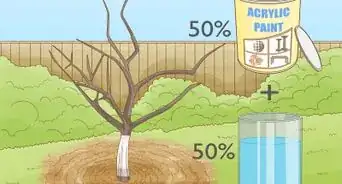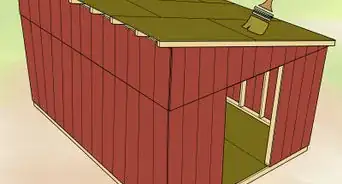This article was co-authored by Ben Barkan. Ben Barkan is a Garden and Landscape Designer and the Owner and Founder of HomeHarvest LLC, an edible landscapes and construction business based in Boston, Massachusetts. Ben has over 12 years of experience working with organic gardening and specializes in designing and building beautiful landscapes with custom construction and creative plant integration. He is a Certified Permaculture Designer, is licensed Construction Supervisor in Massachusetts, and is a Licensed Home Improvement Contractor. He holds an associates degree in Sustainable Agriculture from the University of Massachusetts Amherst.
There are 15 references cited in this article, which can be found at the bottom of the page.
This article has been viewed 34,498 times.
So you're planting a vegetable garden for the first time! To prepare for planting season, choose vegetables you want to plant, pick the perfect site for your garden, and always prep before you plant. While there's no right way to make a vegetable garden, each of these things can help you plan a garden well-adapted to your climate. Once you've got all of these elements figured out, you're ready to create a thriving garden.
Steps
Choosing Vegetables
-
1Pick two or three vegetables to start. New gardeners often make the mistake of planting more than they can handle. For your first season, choose up to three plants that you're adamant about putting in your garden. You can rotate out different plants between planting seasons.[1]
- Check gardening catalogs, both print and online, if you struggle to think of a plant.
- Keep in mind that some plants will produce all season long while others will produce only one time. For example tomatoes, peppers, and squash will continue to produce all season long and they will produce very large yields. However, corn, carrots, and radishes will only produce once.
-
2Try easy-to-grow plants for your first year gardening. Research the planting difficulty of the vegetables you decide on to make sure your choices are suitable for beginners. You don't want to commit to more than you can manage. Choose increasingly difficult plants as your gardening experience increases.
- Beginner-friendly vegetable plants include: carrots, radishes, sugar or snap peas, beets, and lettuce.[2]
Advertisement -
3Select veggies that are native or adaptable to your climate. You don't have to find a plant that only grows in your location, but look for plants adapted to similar climates. If your city is hot and humid, for example, buy plants that love humidity (or vice-versa if you live in a desert).[3]
- Tomatoes, for example, originated in South America but thrive in the similar climate of the Mediterranean.
- Avoid choosing rare or temperamental plants that will require more care than you can give.[4]
-
4Look for vegetables suitable for the season. Vegetables are sorted into two major types: "warm season" and "cool season." Warm season vegetables are planted and harvested from mid-spring to early summer, and cool season vegetables are planted and harvest from late summer to mid-autumn. Pick a variety compatible with the season to keep your plants healthy.[5]
- Warm weather vegetables include: beans, cantaloupes, cucumbers, okras, peppers, peas, sweet corn, tomatoes, and watermelons.
- Cool weather vegetables include: beets, broccoli, cauliflower, onions, potatoes, radishes, and turnips.
-
5Look for disease-resistant plants or seeds. Check a seed catalog or ask a plant nursery employee to find plants equipped to combat blights or fungal diseases. Preventative measures can keep diseases from spreading and ravaging all the plants in your garden.[6]
-
6Pick plants that you have enough room to accommodate. Some plants, like corn, grow very tall and others, like cucumbers, have vines that require fences or trellises. Research every potential plant's growing process so you don't choose a plant larger than what you have room for.
- Never judge a plant by its seedling, as some begin deceivingly small.
- Vegetables ideal for small spaces are: tomatoes, lettuce, pole beans, chard, radishes, eggplants, avocados, lemons, and most herbs.[7]
Finding the Right Site
-
1Determine how much space you will need. Research how much space each of your plants will need. Tomatoes, for example, may need more space than peppers. Depending on how much space you have available, choose how many of each plants you will grow.
- Make sure to leave enough space in your garden to walk around in it as well. You will need enough room to weed, water, and harvest your garden.
-
2Choose a place that receives six to eight hours of sun. Most vegetable plants require "full sun" conditions, which means that they need at least six hours of sun per day. Without it, they cannot grow very large. Avoid spots that are shaded by trees or your home during the afternoon.[8]
- Check your plants' growing conditions for specific details on how much sun they need.
- If your only available spot for a garden does not get full sun, then you can also grow plants that only require partial sun, such as spinach and lettuce.
- If you live in a hot climate, then you may want to avoid plants that require partial shade, such as peas.
-
3Locate a spot with a portable water supply. Water in large quantities, especially enough to water a garden, is heavy. Choose a spot that can be reached by sprinklers, a hose, or irrigation system. If none are available, pick a spot close to your home so you won't have to carry water far.[9]
- Most plants need at least 1 inch (2.5 cm) of water per week. Check your plants' growing conditions for detailed instructions.
-
4Place your garden at a spot with a wind barrier. Plants with no obstructions against the wind are at risk of getting damaged, dried out, or blown over. Choose a place next to a slatted fence, hedge, or small grove of trees.[10]
-
5Look for an area with well-draining soil. Vegetables generally do best in moist, well-draining soil. To test your soil for drainage, dig a 12–18 inches (30–46 cm) by 12–18 inches (30–46 cm) hole in the ground. Fill the hole with water and observe how long it takes for the water to sink into the ground. Soils with better draining properties will lose water quickly.[11]
- Ten minutes or less is the ideal. Any longer, and your soil may have poor drainage.
- You may also consider planting in a raised garden box to ensure good drainage.
-
6Find a community garden if you live in the city. Urban gardening can seem impossible, but many cities offer communal gardens where anyone can plant seeds. Search online for nearby community gardens and check how much membership fees cost. Choose a location that best fits your vegetables and your budget.[12]
Preparing to Plant Your Garden
-
1Plot out your garden on paper. Your drawing does not have to be overly-detailed but can function as a guide while planting. Outline the rough shape of your garden. Choose a symbol (like an X or O) for each plant so you know where you'll plant every vegetable in the garden.[13]
- Write down planting dates next to each drawing for future reference.
-
2Create a planting schedule for each of your vegetables. You don't need to plant all your vegetables at once. Grow two or three varieties at a time, warm weather plants first and cool weather plants later. Planning when you will grow each plant can help you achieve a higher yield.[14]
- To check the best planting season for a specific vegetable, try the Almanac's planting dates guide.
-
3Arrange your plants in a space-efficient way. Once you know how much space each plant needs, pay attention to these factors while organizing them. Place tall vegetables on the north side of your garden so they won't shade shorter vegetables. Then, group the plants further by timing: put plants that will mature at the same time together to make harvesting easier.[15]
-
4Make sure each vegetable has enough space to thrive. Taller vegetables usually have wider-reaching roots and require more space. Research every plant beforehand to make sure you space them far enough apart. Taking this into account will help you prevent one plant stealing water or soil nutrients from another.
-
5Choose an organic fertilizer for your plants. Organic fertilizers are better adapted to vegetable gardens because they supply slow and steady nutrients. This can help your plants fight off fungal and bacterial diseases. Chemical fertilizers, while often inexpensive, do not contribute organic matter.[16]
- Organic fertilizers are usually easy to make at home.
Community Q&A
Did you know you can get expert answers for this article?
Unlock expert answers by supporting wikiHow
-
QuestionWhat are the factors to consider in planning a vegetable garden?
 Ben BarkanBen Barkan is a Garden and Landscape Designer and the Owner and Founder of HomeHarvest LLC, an edible landscapes and construction business based in Boston, Massachusetts. Ben has over 12 years of experience working with organic gardening and specializes in designing and building beautiful landscapes with custom construction and creative plant integration. He is a Certified Permaculture Designer, is licensed Construction Supervisor in Massachusetts, and is a Licensed Home Improvement Contractor. He holds an associates degree in Sustainable Agriculture from the University of Massachusetts Amherst.
Ben BarkanBen Barkan is a Garden and Landscape Designer and the Owner and Founder of HomeHarvest LLC, an edible landscapes and construction business based in Boston, Massachusetts. Ben has over 12 years of experience working with organic gardening and specializes in designing and building beautiful landscapes with custom construction and creative plant integration. He is a Certified Permaculture Designer, is licensed Construction Supervisor in Massachusetts, and is a Licensed Home Improvement Contractor. He holds an associates degree in Sustainable Agriculture from the University of Massachusetts Amherst.
Garden & Landscape Designer
-
QuestionWhat vegetables should you plant next to each other?
 Maggie MoranMaggie Moran is a Professional Gardener in Pennsylvania.
Maggie MoranMaggie Moran is a Professional Gardener in Pennsylvania.
Home & Garden Specialist
-
QuestionWhat month should you plant vegetables?
 Maggie MoranMaggie Moran is a Professional Gardener in Pennsylvania.
Maggie MoranMaggie Moran is a Professional Gardener in Pennsylvania.
Home & Garden Specialist
References
- ↑ https://dengarden.com/gardening/Planting_Your_First_Vegetable_Garden
- ↑ https://www.weedemandreap.com/5-vegetables-beginner-gardener/
- ↑ http://modernfarmer.com/2016/01/choosing-vegetable-seeds/
- ↑ http://sonomamg.ucanr.edu/files/30944.pdf#
- ↑ http://gardeningsolutions.ifas.ufl.edu/plants/edibles/vegetables/selecting-vegetables.html
- ↑ http://www.nwedible.com/how-to-pick-your-vegetable-seeds-without-going-crazy/
- ↑ https://morningchores.com/vegetables-in-small-spaces/
- ↑ http://www.finegardening.com/video-how-start-vegetable-garden-selecting-site
- ↑ https://content.ces.ncsu.edu/home-vegetable-gardening-a-quick-reference-guide
- ↑ https://www.growveg.com/guides/choosing-the-best-position-for-your-vegetable-garden/
- ↑ http://www.bhg.com/gardening/vegetable/vegetables/planning-your-first-vegetable-garden/
- ↑ https://www.choice.com.au/outdoor/gardening/products-and-advice/articles/starting-a-vegetable-garden
- ↑ https://extension.illinois.edu/veggies/basics.cfm
- ↑ https://extension.illinois.edu/veggies/basics.cfm
- ↑ https://agrilifeextension.tamu.edu/browse/featured-solutions/gardening-landscaping/planning-a-garden/
- ↑ http://www.dummies.com/home-garden/gardening/vegetable-gardening/choosing-a-fertilizer-for-your-vegetable-garden/
About This Article
To plan a vegetable garden, choose veggies that are native or adaptable to your climate. Research how much space they need to thrive, then choose a location to accommodate them. Make sure the spot gets 6-8 hours of direct sunlight every day and provides good soil drainage. Then, plant the veggies according to their space and depth requirements, and be sure to leave plenty of room between the plants and rows. Water your plants regularly and monitor for pests until your veggies are ready to harvest. To learn more from our Horticulturist co-author, like how to fertilize your vegetables, keep reading the article!








































































